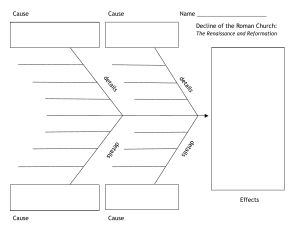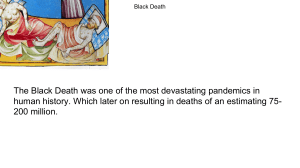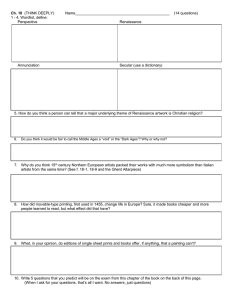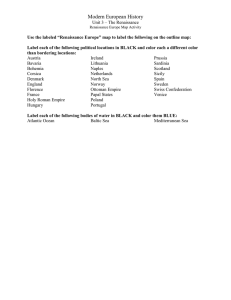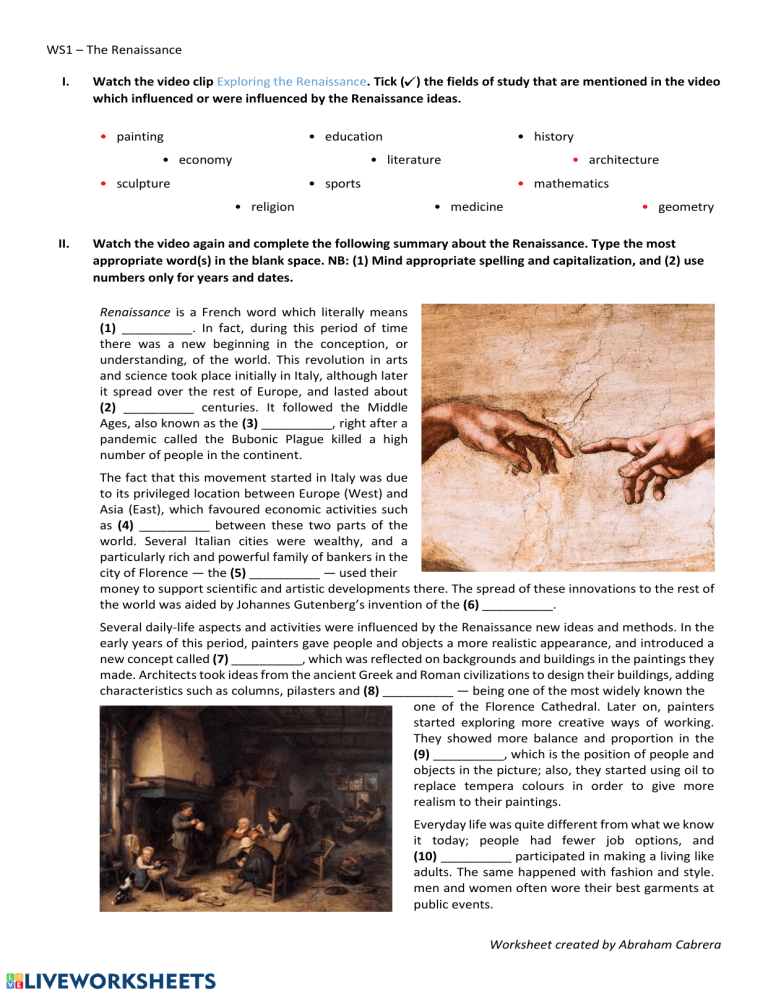
WS1 – The Renaissance I. Watch the video clip Exploring the Renaissance. Tick ( ) the fields of study that are mentioned in the video which influenced or were influenced by the Renaissance ideas. • painting • education • economy • literature • sculpture • architecture • sports • religion II. • history • mathematics • medicine • geometry Watch the video again and complete the following summary about the Renaissance. Type the most appropriate word(s) in the blank space. NB: (1) Mind appropriate spelling and capitalization, and (2) use numbers only for years and dates. Renaissance is a French word which literally means (1) __________. In fact, during this period of time there was a new beginning in the conception, or understanding, of the world. This revolution in arts and science took place initially in Italy, although later it spread over the rest of Europe, and lasted about (2) __________ centuries. It followed the Middle Ages, also known as the (3) __________, right after a pandemic called the Bubonic Plague killed a high number of people in the continent. The fact that this movement started in Italy was due to its privileged location between Europe (West) and Asia (East), which favoured economic activities such as (4) __________ between these two parts of the world. Several Italian cities were wealthy, and a particularly rich and powerful family of bankers in the city of Florence — the (5) __________ — used their money to support scientific and artistic developments there. The spread of these innovations to the rest of the world was aided by Johannes Gutenberg’s invention of the (6) __________. Several daily-life aspects and activities were influenced by the Renaissance new ideas and methods. In the early years of this period, painters gave people and objects a more realistic appearance, and introduced a new concept called (7) __________, which was reflected on backgrounds and buildings in the paintings they made. Architects took ideas from the ancient Greek and Roman civilizations to design their buildings, adding characteristics such as columns, pilasters and (8) __________ — being one of the most widely known the one of the Florence Cathedral. Later on, painters started exploring more creative ways of working. They showed more balance and proportion in the (9) __________, which is the position of people and objects in the picture; also, they started using oil to replace tempera colours in order to give more realism to their paintings. Everyday life was quite different from what we know it today; people had fewer job options, and (10) __________ participated in making a living like adults. The same happened with fashion and style. men and women often wore their best garments at public events. Worksheet created by Abraham Cabrera WS1 – The Renaissance III. Watch the video once more. Decide whether the following statements are true (T) or false (F). TRUE FALSE 1 The influence of Renaissance was more easily observed in science than in art. • • 2 Tempera is similar to oil because both were obtained from inorganic substances. • • 3 Most Renaissance artists were highly skilled at multiple disciplines. • • 4 Some leisure activities during the Renaissance involved the use of animals. • • 5 Before this time, most music had been strictly devoted to religious activities. • • IV. Drag and drop the following less-common words from the video where they belong in the sentences. Use a dictionary to look up their meanings if necessary. NOTE: The letter in parentheses indicates the type of word it is. 1 midwife (n) a During the Renaissance, it was common for artists to look for wealthy people to __________ their work. 2 sponsor (v) b Renaissance artists set themselves high standards and were determined to __________ for them. 3 strive (v) c In some parts of the world, pregnant women still decide to use the help of a __________ instead of going to a hospital to give birth. 4 seamstress (n) d Women were an important part of fashion design at that time, and when people needed some clothes made they went to see a __________. “We know what we are, but know not what we may be.” — William Shakespeare, Renaissance artist. — Worksheet created by Abraham Cabrera
